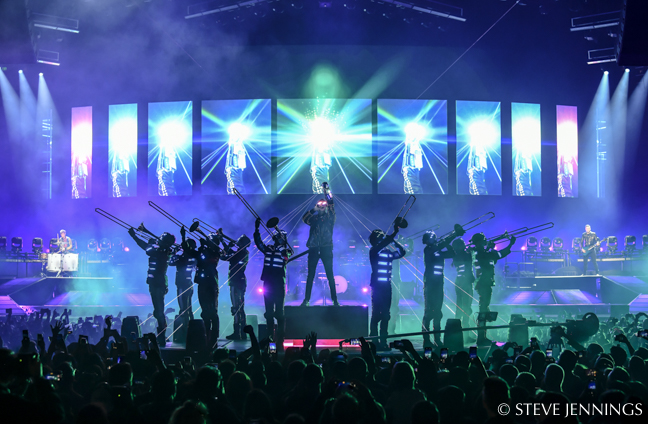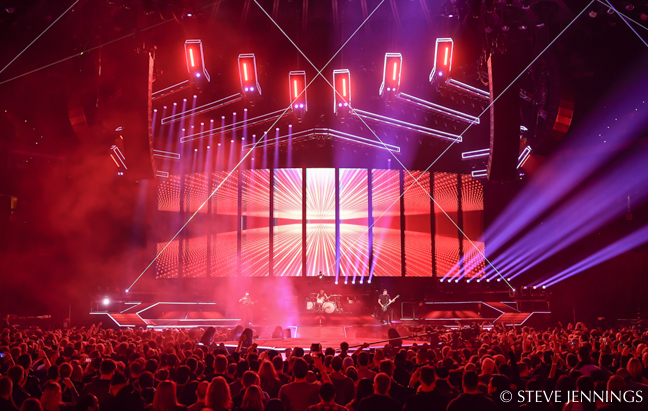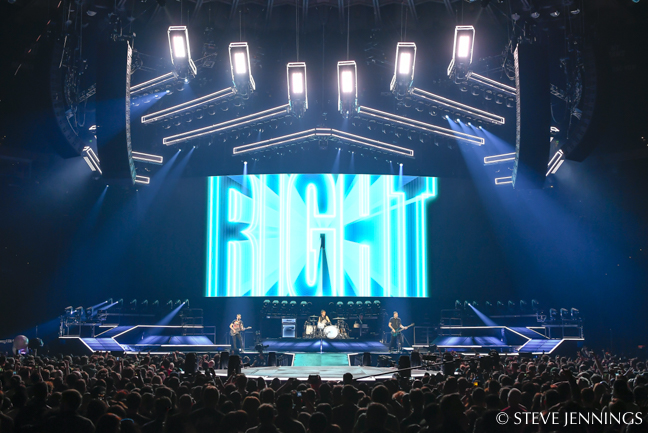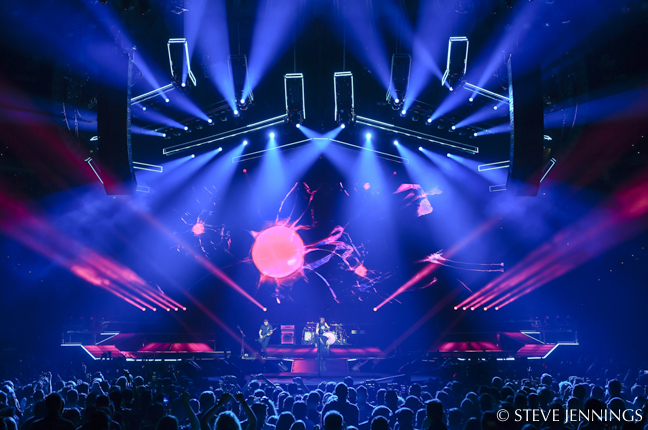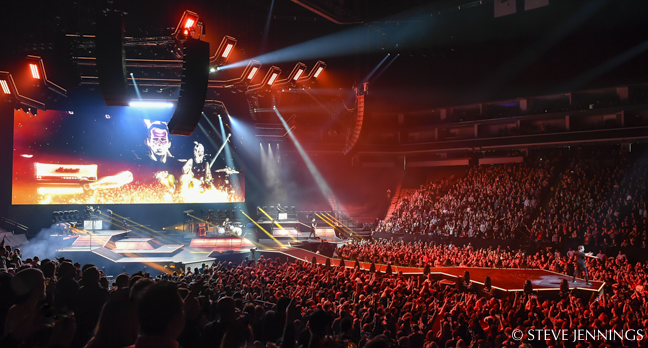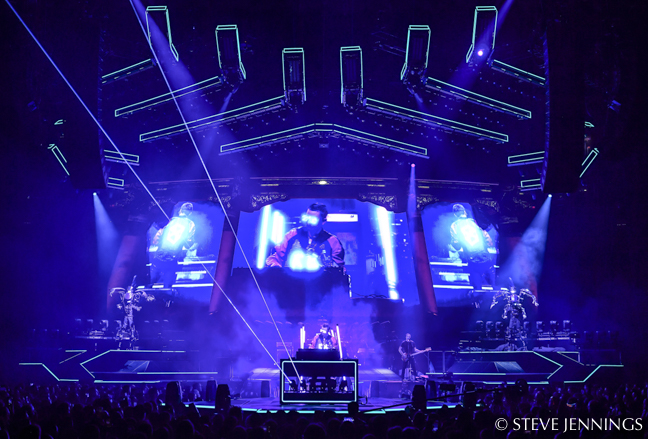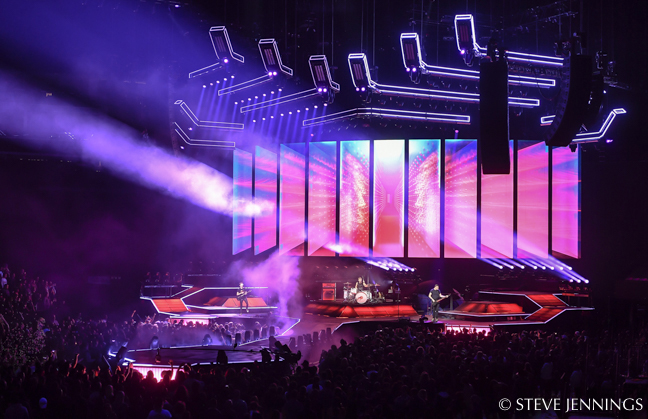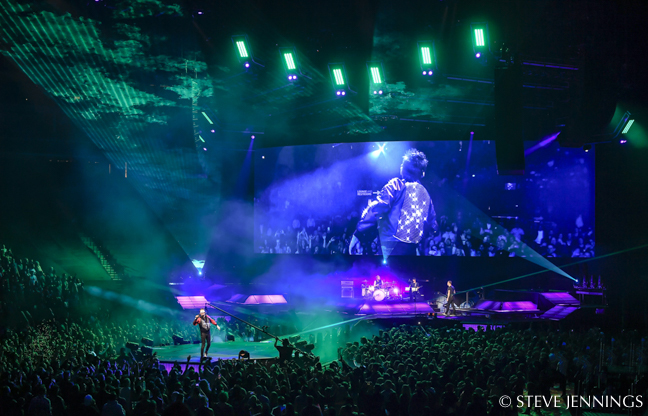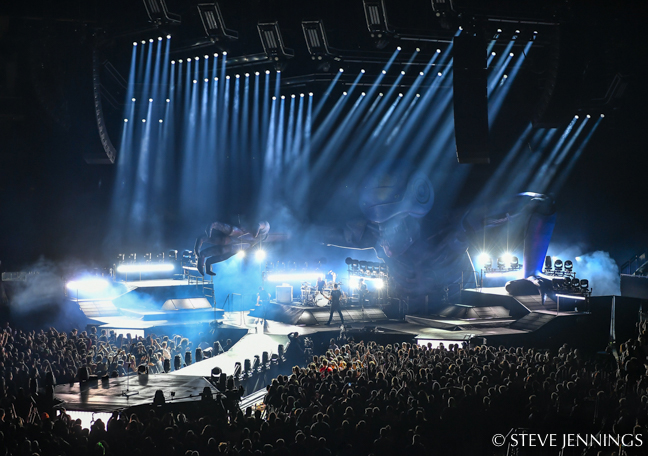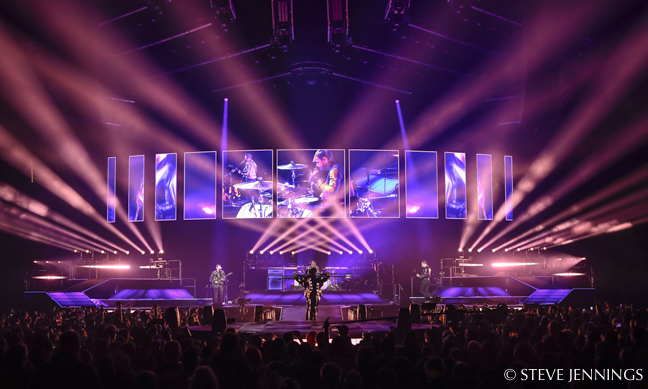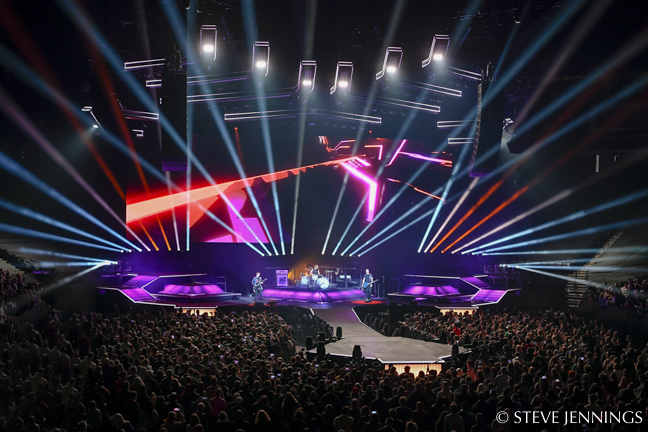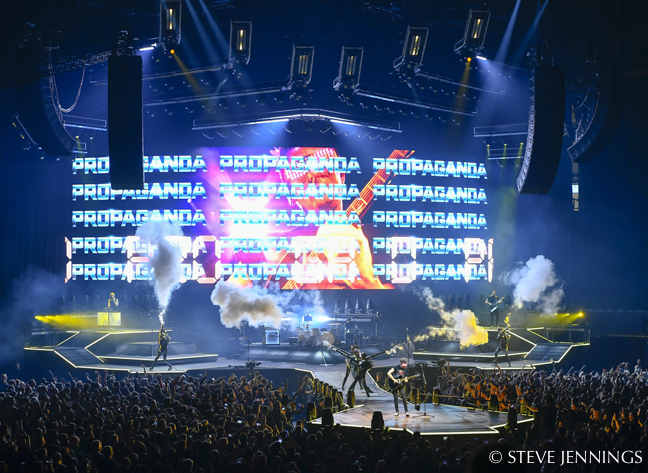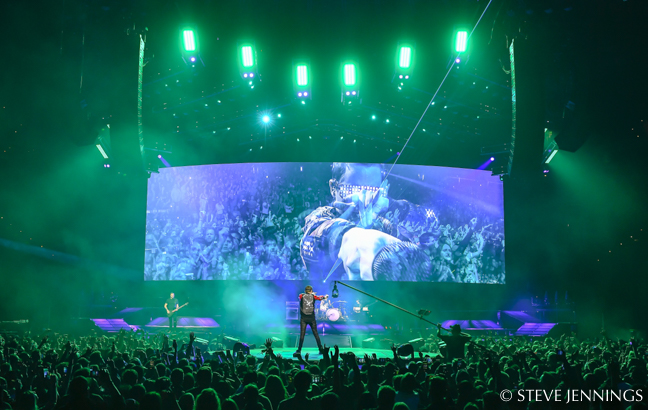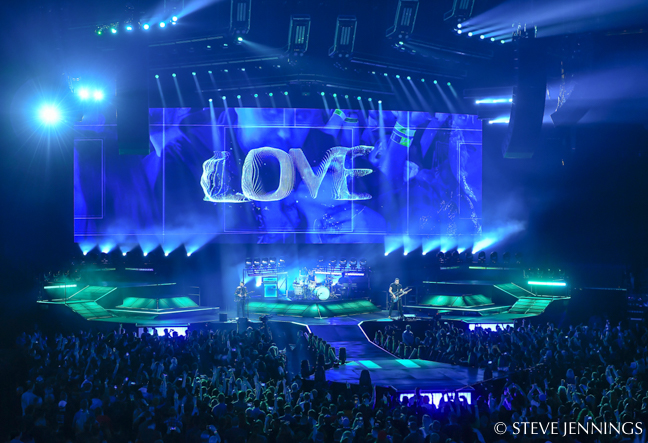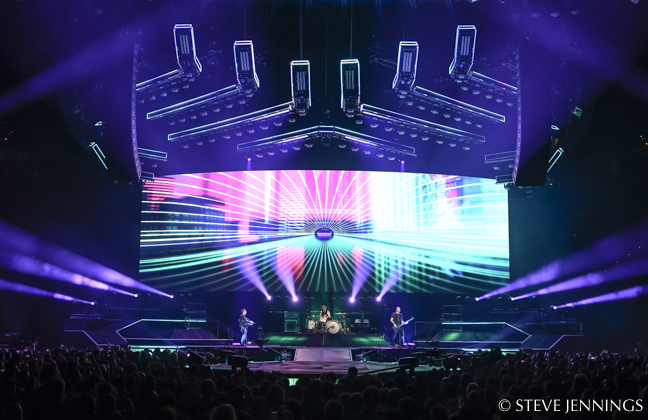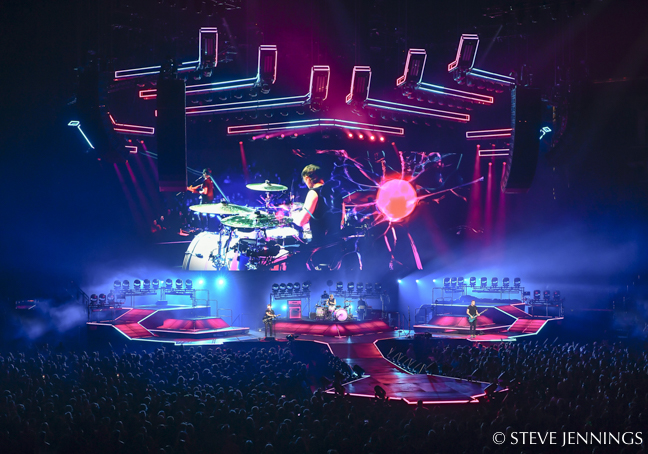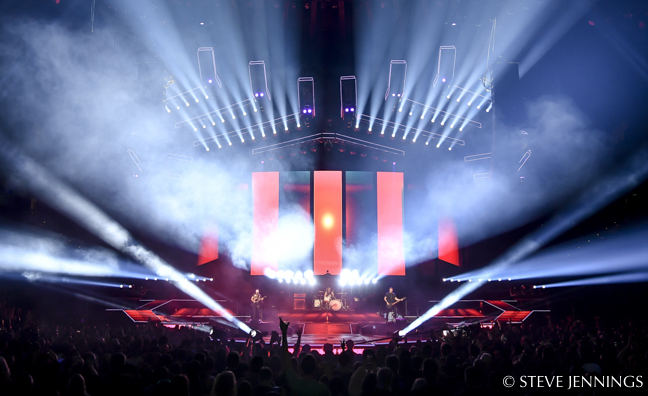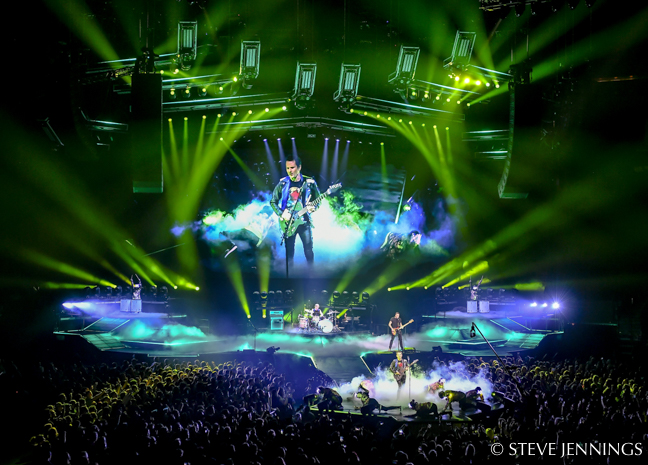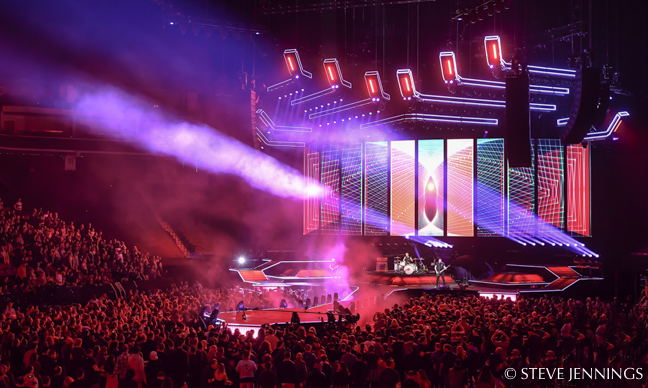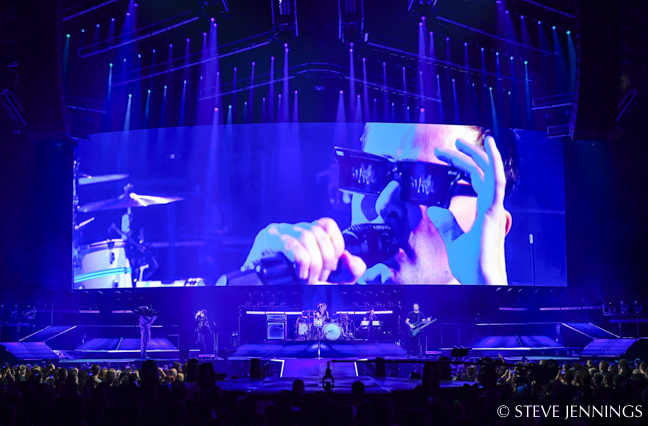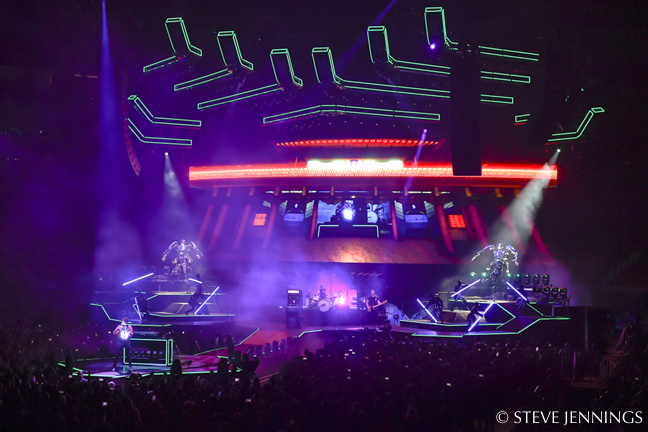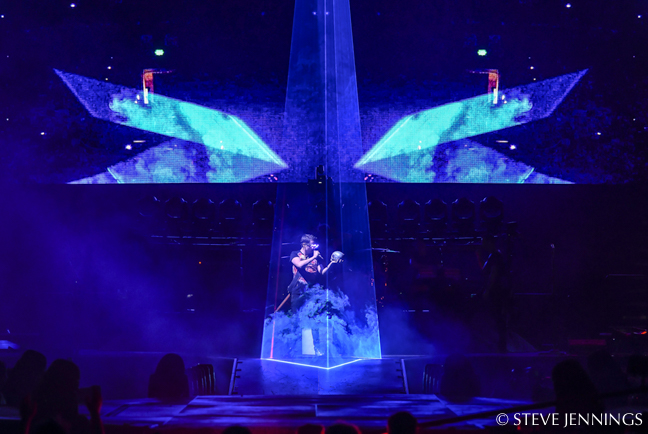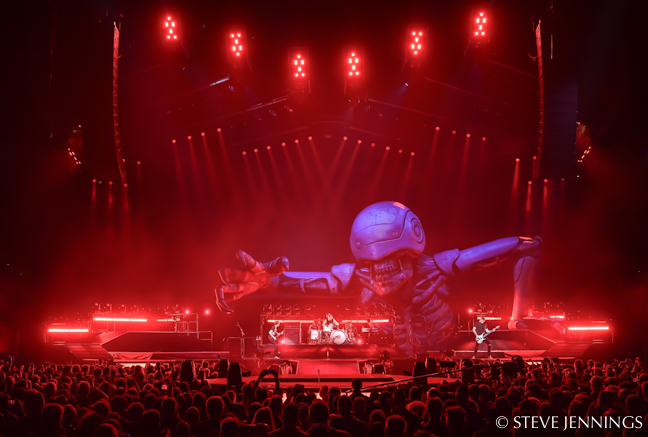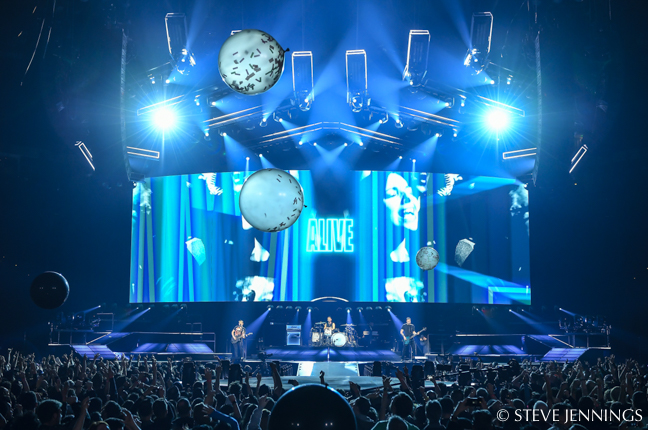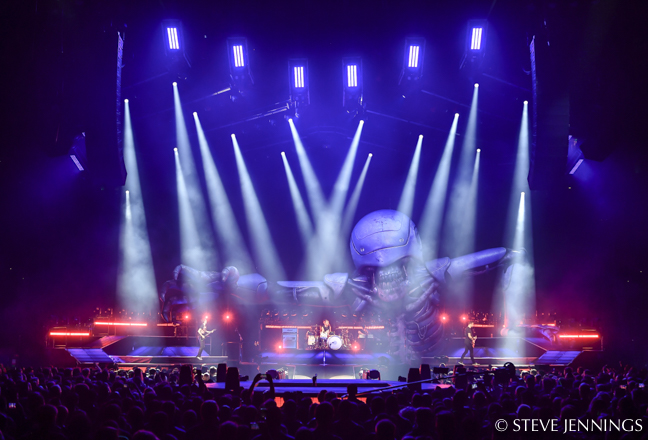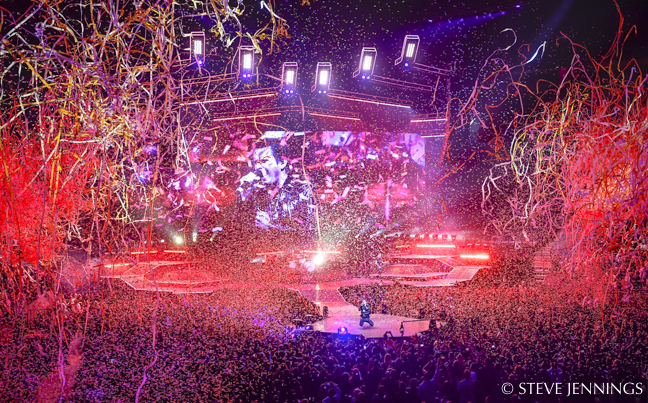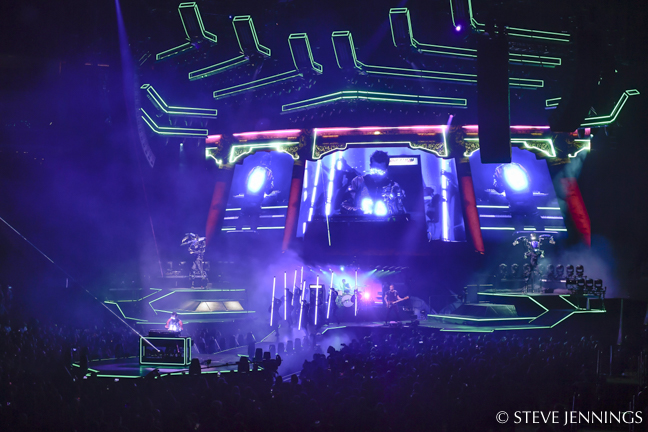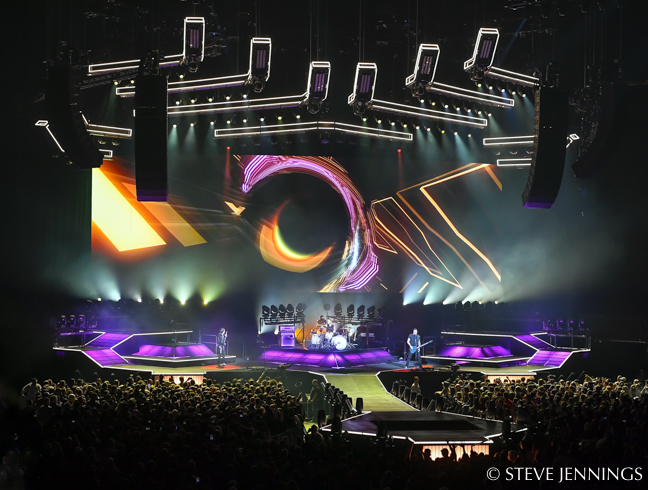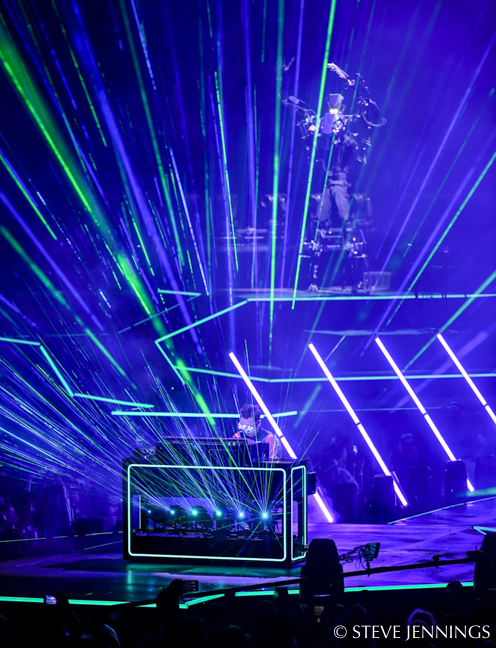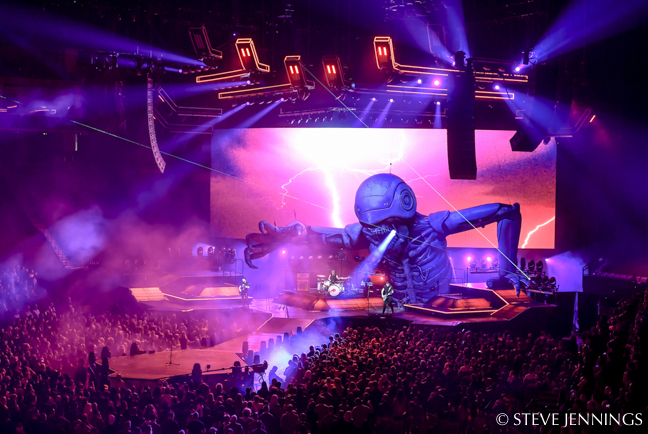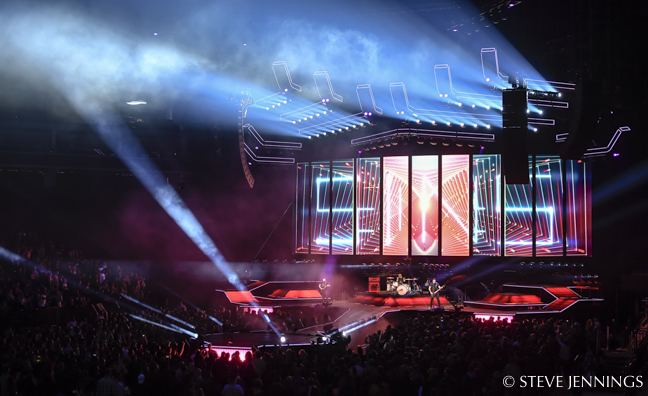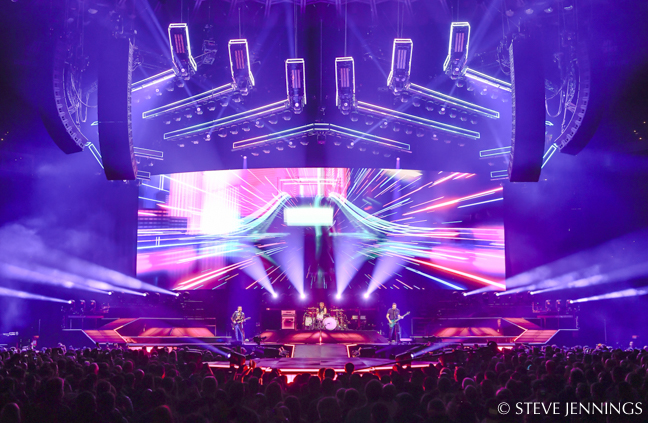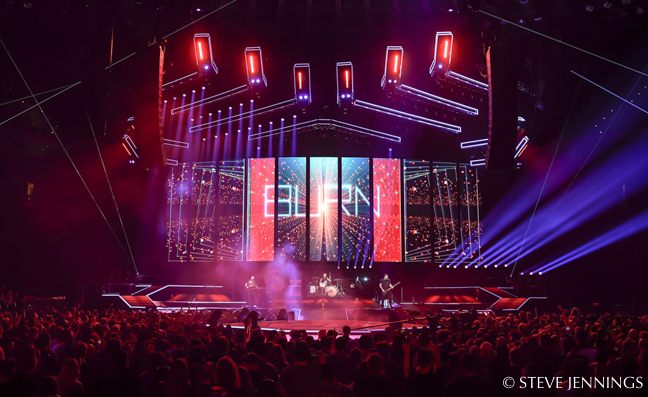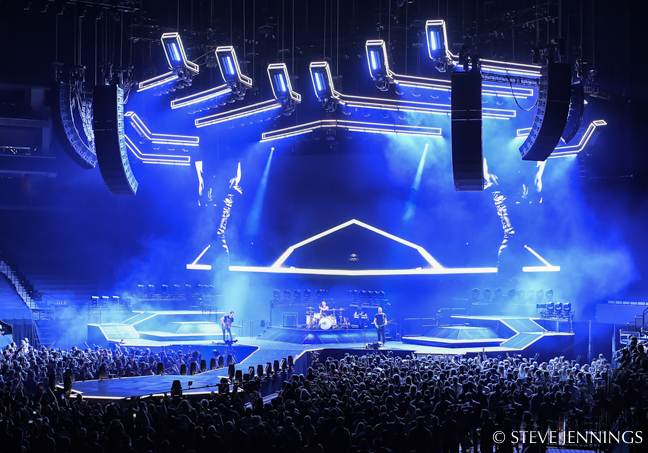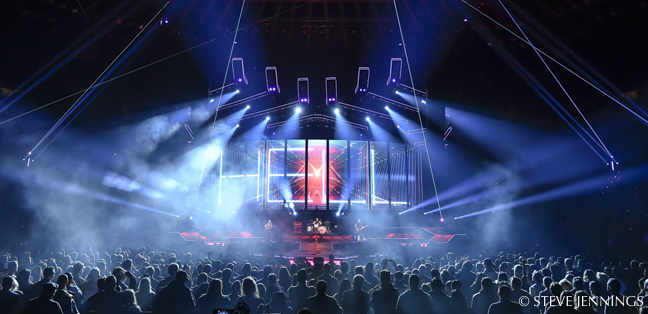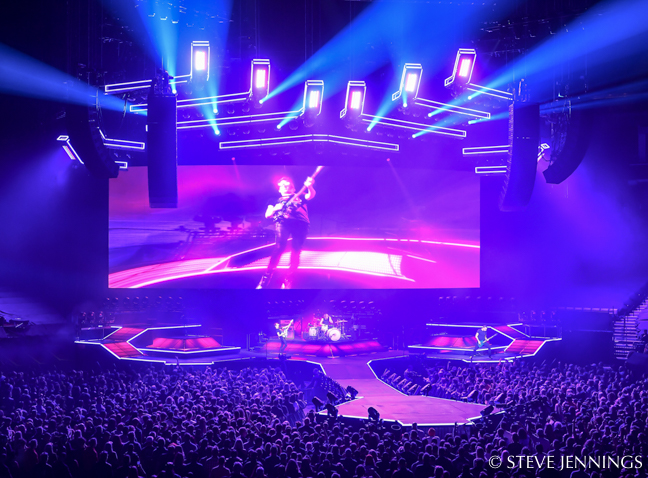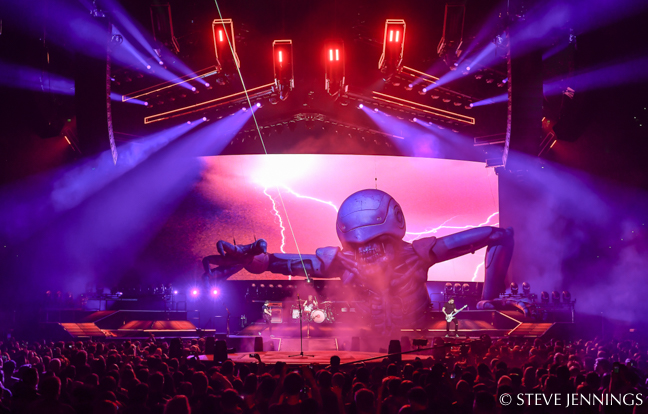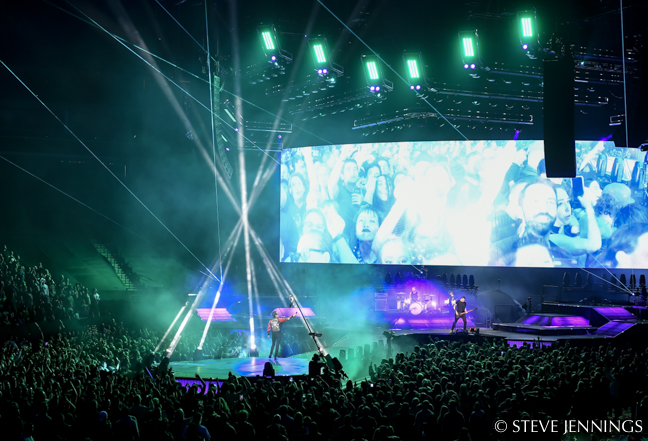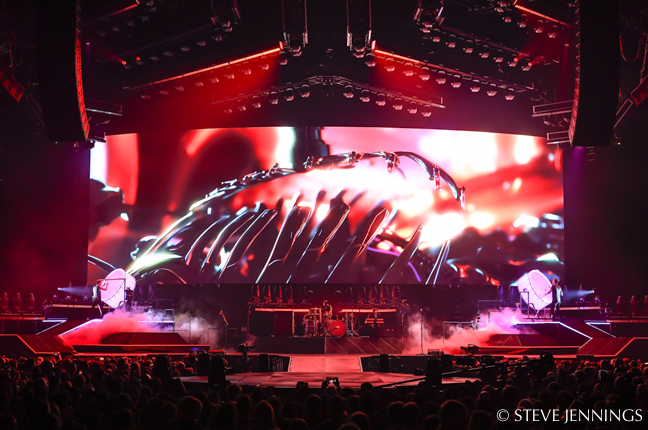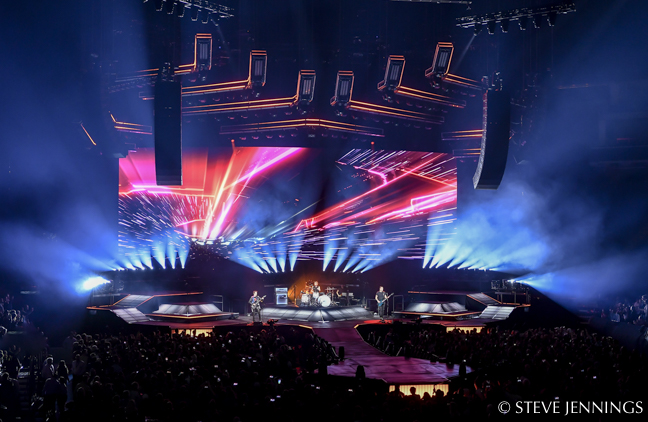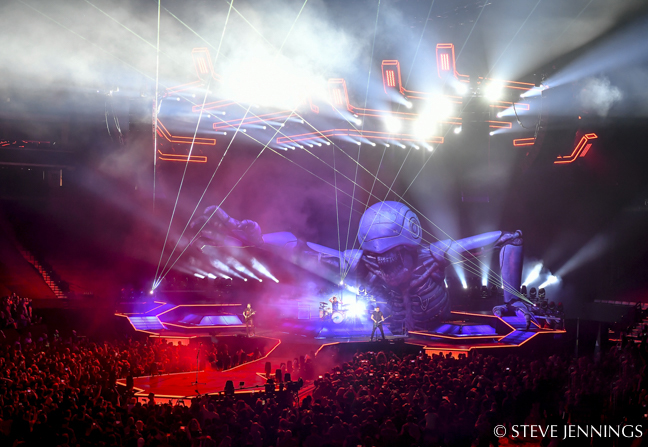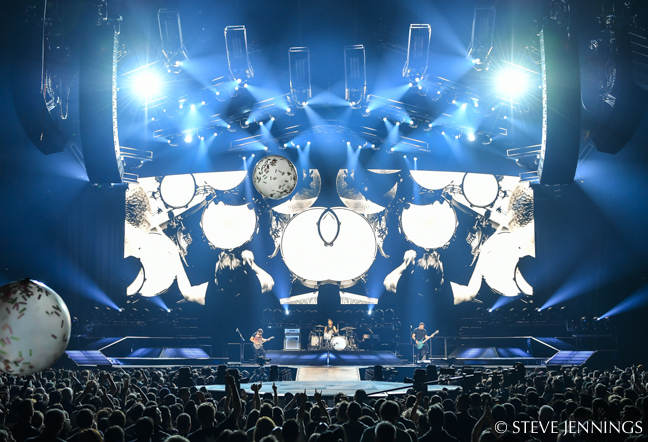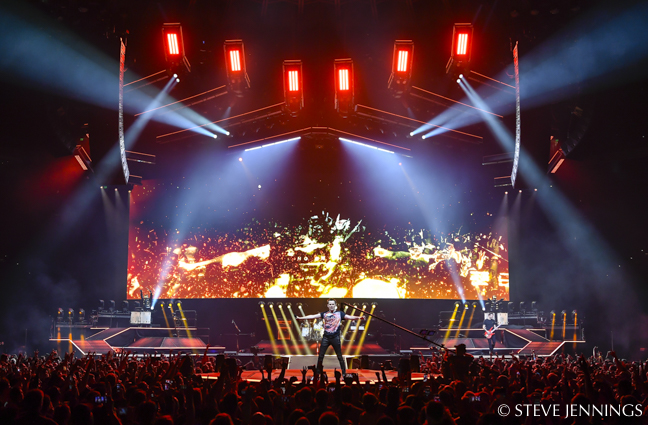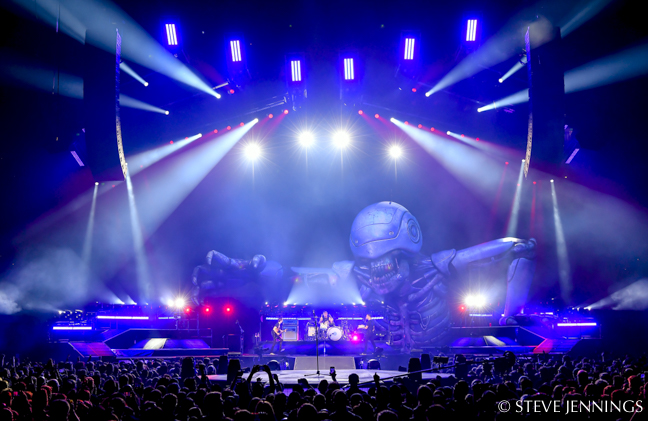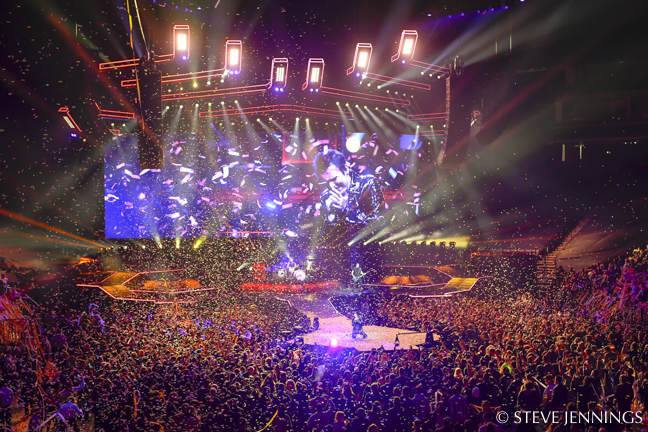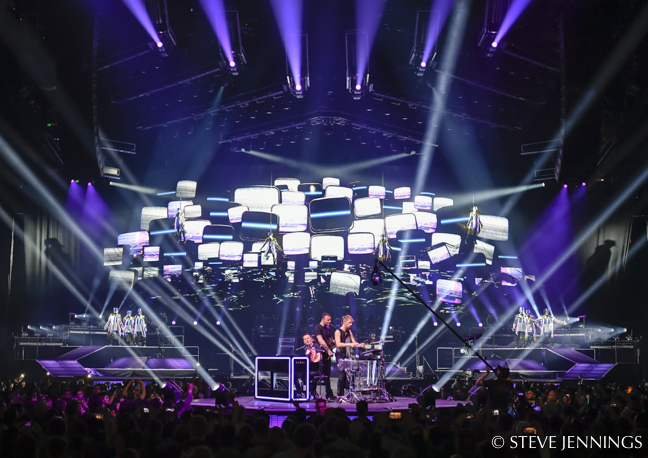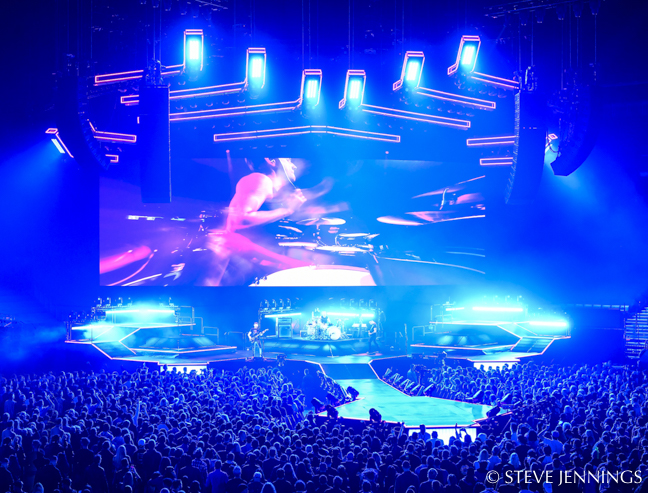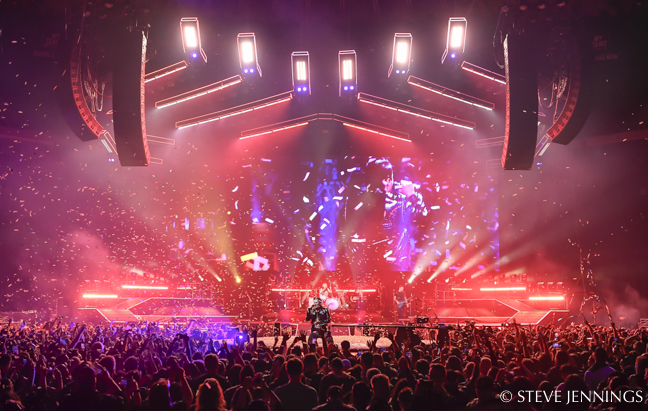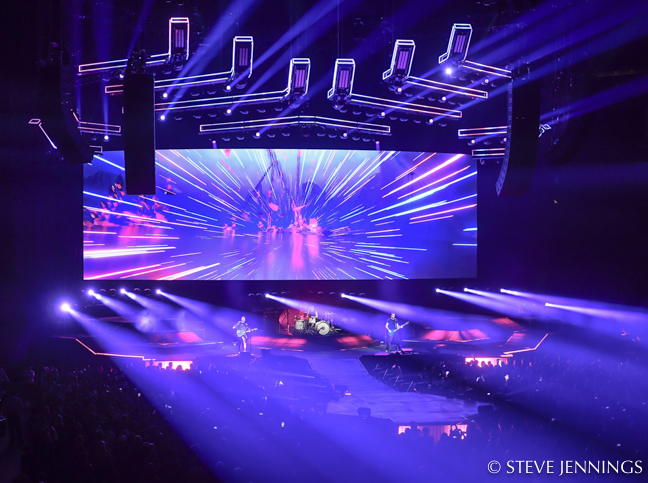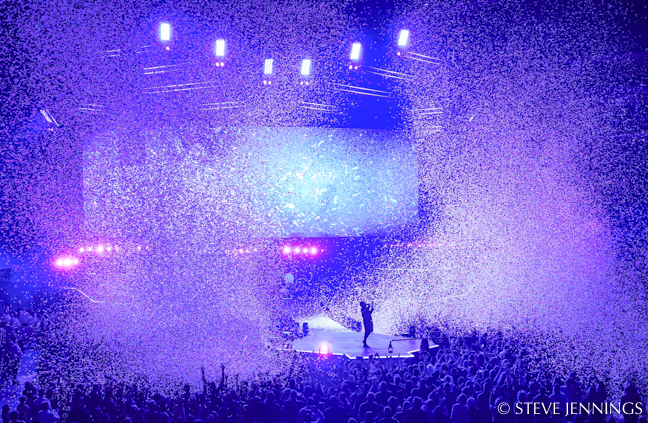
For Muse fans new and old, the current tour is yet another notch up the ladder of musical and visual excellence. The show’s North American leg, which ran from February to April, will be followed by a tour through the U.K. and Europe this summer, wrapping up with some dates in Asia and Latin America this fall. Supporting the album of the same name, which was released last November, the Simulation Theory world tour has everything you’d expect and more this time around. We spoke with key members about the show and its visual grandeur — Jesse Lee Stout, creative director / production designer (and also video content director); Sooner Routhier, lighting designer and programmer; Aaron Luke, lighting director; Tom Kirk, video director; and Miles Baldwin, laser operator and Special Effects crew chief.

Jesse Lee Stout
Creative Director and Production Designer
Jesse Lee Stout notes that he first worked with Muse when directing all the video content and interactive elements of the Drones Tour’ in 2015. Matt Bellamy (vocals, guitar, keys) had this vision of the concert telling the story of this androgynous, god-like character that he called The Dictator. In creating that, they really meshed well on the aesthetic treatment he was bringing as well as other creative concepts.
“After Drones, the band asked me to take a larger role as creative director and production designer for their festival run. They had some hard restrictions — the production needed to fit into one truck. I developed a series of 11 kinetic volumetric monoliths with embedded lighting and LED video panels on the downstage edge. Again, the band and I had a good vibe on the creative and execution of that show. Fast forward to last year, when they were writing their current album Simulation Theory. They came back to me with an even more exciting offer to be their Creative Director throughout the entire album campaign. This would ensure a holistic and cohesive conceptual and aesthetic thread throughout their campaign. We started off with press photos and styling, art directed and designing the album packaging, some VR games and then it was concert time.”

Since Stout had already been working with the band on the Simulation Theory campaign, the show was being discussed at the same time. This was a perfect setup to jam with the band on concepts, gags, and more in a more casual manner. The band members are really involved in the creative process (and all very calculated in their creative decisions) and while they were working on other creative elements for the campaign, they’d think of things to go into the show, Stout notes. “While directing the album art, we were gelling on all this 80’s Sci-Fi movies theme and thought, ‘We need a spaceship, and that should inform the stage too.’
“So I came up with a design for the spaceship for the album art, and at the same time, thinking about what parameters we had for the stage. They were kind of both designed at the same time. Also, my initial design for the spaceship is a little Easter egg in the ‘Pressure’ music video. The kids go into a science lab in their high school, and a little hanging mobile of the solar system has the ship up there, too. So yeah, the band, the music video director (Lance Drake) and I would bounce ideas back and forth like, ‘We wanna put this thing in the show, why don’t we find a home for it in a music video too?’ Or, ‘We’re thinking about this sort of thing for a music video, stop the press on the album, art and let’s squeeze that scene into the cover art too.’ This process was the perfect formula for a band to create a consistent artistic statement.”
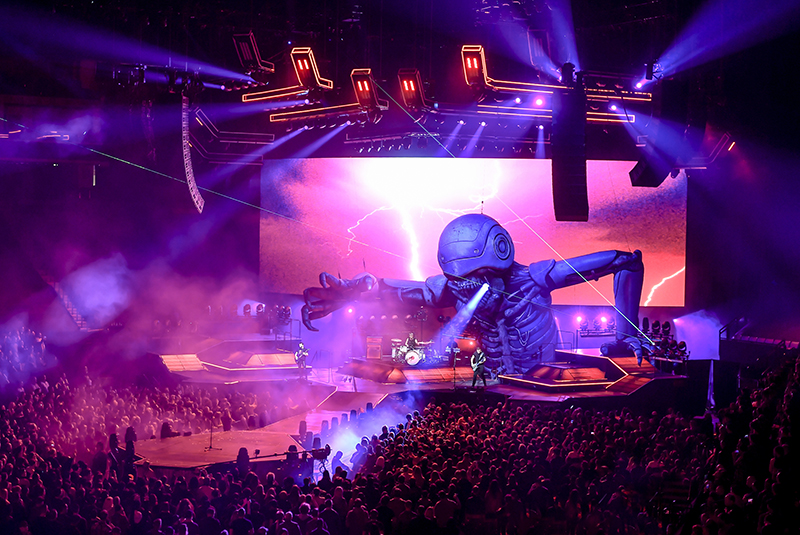
Stout says the hardest challenge with a band of the magnitude of Muse is that they’ve done and seen everything. Flying drones, kinetics, lasers, 3D scanners with real-time effects, pyro, etc. “Therefore, we had to go out of the box hard on this. What have they not done? Dancers, for one (granted, they had a couple of performer skits at a stadium one-off years ago), but would it work for a rock band, and more importantly, with their fan base. This was a welcome challenge for all of us, and I helped steer it into a way that made sense for the Muse world. There’s no ‘dancing’ per se, they’re more characters that define the universe we create with each song. Those wound up being my favorite songs in the show — ‘Propaganda’ with female assassins, ‘Thought Contagion’ with zombies circling Matt [Bellamy] as he solos, ninjas and exoskeletal walkers straight out of ALIENS in the song ‘Algorithm’ — it was an incredible feat. Those exoskeletons are from this small company in Japan that I found that don’t speak English. I brought on a translator to help us negotiate getting this deal.”

There are always things that get reduced, though, due to constraints in touring, seat kills, safety, and cost, and this was no different, notes Stout. “However, I was lucky enough to have such a solid and dedicated team on this show. I had a lot of vendors on the first day saying, ‘You wanna do what with our product?!” But they saw the vision, and we worked together to make things achievable, and everyone is super-happy in the end — really great team players. The production manager, George Reeves, was also crucial in getting some of these crazy ideas into a touring environment. Without a PM that truly wants to make creative ideas happen, you’ll get nowhere in creating a dynamic show.”

Stout says that Tait were amazing (as usual), and their production manager Todd Vernon really came through in getting everything the way he wanted it. “We quickly realized that the ‘neon’ outlining the staging and trussing were a huge look, but we needed to alter the mounting to get maximum visibility. They totally agreed and were eager to help make the show look better. Their stuff fits into the trucks on the first attempt and lasts.
“When it came to props/inflatables, Airworks have no competition as far as I’m concerned. Their work is so good that it freaks me out. Matthew Whitehead brought so many great details to our Roboskeleton, which I’ve named ‘Murph’ (you know, like ROBOCOP). All the moving parts on him, from the jaw to the articulating fingers and puppeteering parts, were really encouraged by Whitehead. At rehearsals, he helped us get those violent shakes out of Murph with full confidence that his product could endure anything.

“All the content teams really busted out some great stuff too. Silent Partners handled the majority of the Notch-based stuff along with Hidden Road Studios. We went beyond traditional I-Mag filters and actually created a lot of animation inside Notch itself. Frame48 created all the hyper-glossy synthwave 3D animation that came out stellar. ER Productions handled all of the traditional special effects and again, were another team that worked outside of the box to bring unique stuff to the show.”
Stout gives a massive shout out to Cristina Acevedo, the costume designer and band stylist. “NASA should take note on the iridescent visors she put on the hazmat suits that are crazy fresh. The Blade Runner-esque futuristic choir she created, the hyper-glossy ninjas, and Matt Bellamy’s high-density LED leather bomber! Also, Antonio [Slimors] at LED Clothing, who worked with us to create the most polished, bespoke LED clothing I’ve ever seen. Their stuff is incredible, even up close.”
Stout thanks “Sharky” [Sean Harper] and “Waffles” [Steven Lemahieu] at PRG for letting him have hazmat-suited performers rappel and walk on the surface of their video wall — and “to Sharky for climbing into a hazmat suit himself to film Matt on stage for the song ‘Madness’ (gotta stay in character).”
He also credits Upstaging “for making sure the illuminated ninja Bo staffs continue to work after being slammed against the stage decking repeatedly in the choreography. Seth [Conlin, Upstaging’s crew chief] and the team really put in the effort to make sure it was all perfect.” And he also commends Andrew Winghart, “the choreographer, who helped me get these non-dancing performances to be so dynamic.”
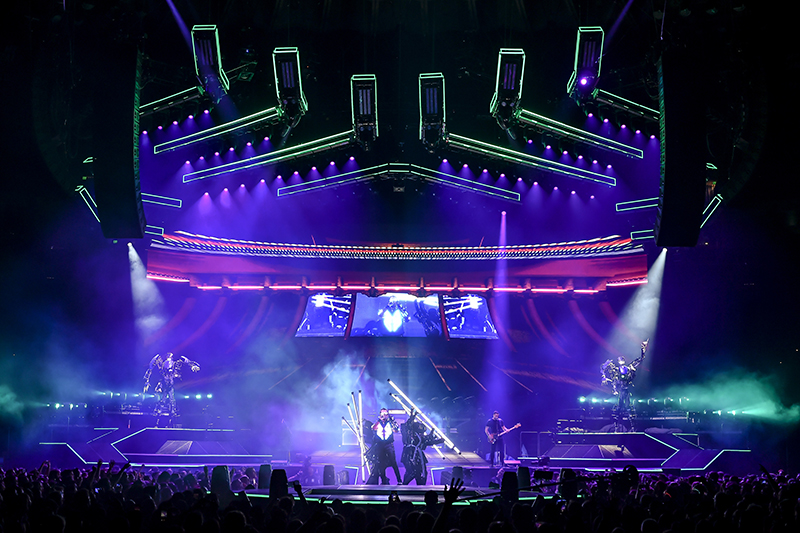
Stout adds that there were so many little boutique vendors on this gig that they brought on, and that’s part of what makes this such a unique show. “I had a custom chrome-dipped Power Glove created for Matt Bellamy that is also a playable instrument,” he enthuses. “The exoskeletons, the arcade machine, the illuminating orchestral drums (I won’t call them ‘Taikos’ anymore, Jeremy), and the two-way mirror masks with hidden LED panels in them — are all the result of a variety of heads coming together to make this SIMULATION real.”
Stout concludes by noting how “Matt Bellamy and Dom Howard are both very involved in the process. While they both chimed in on everything, Dom and I worked closer on the print-related stuff like merch and album packaging, and Matt and I [worked] on the show script. It was very productive having such an easy rapport with them — I would just text back and forth ideas, thoughts — making everything move quickly and for a more casual feel.”
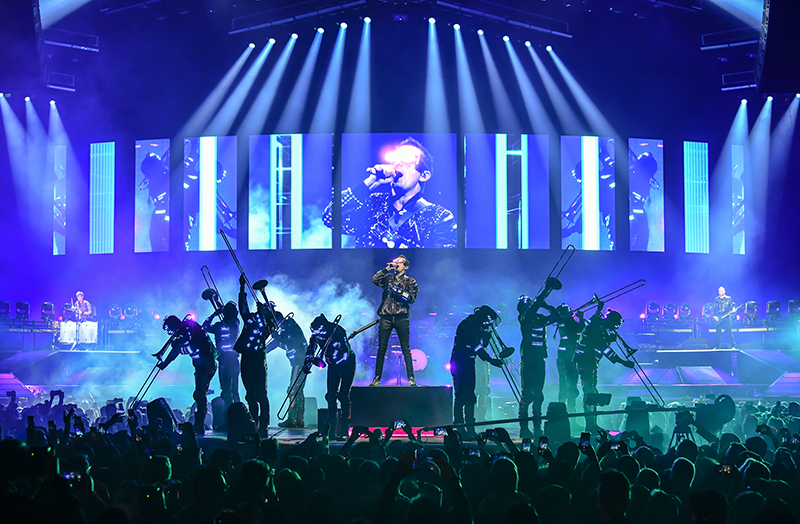
Sooner Routhier
Lighting Designer/Programmer
Jesse Lee Stout contacted Sooner Routhier and asked if it was okay for him to put her name in for a lighting design for an upcoming tour. But there was a catch. He told her that he couldn’t divulge the name of the band at the time, and she would need to block off all of the fall of 2018, plus January and February 2019, in her schedule. Tall order!
“He also stated that the show was going to be in arenas in North America and stadiums in Europe,” Routhier says. “I was obviously very curious about the full scope of the project. But I absolutely love collaborating with Jesse and will do just about any project he asks me to join in on! I’m not sure exactly how he pitched me to the band.”
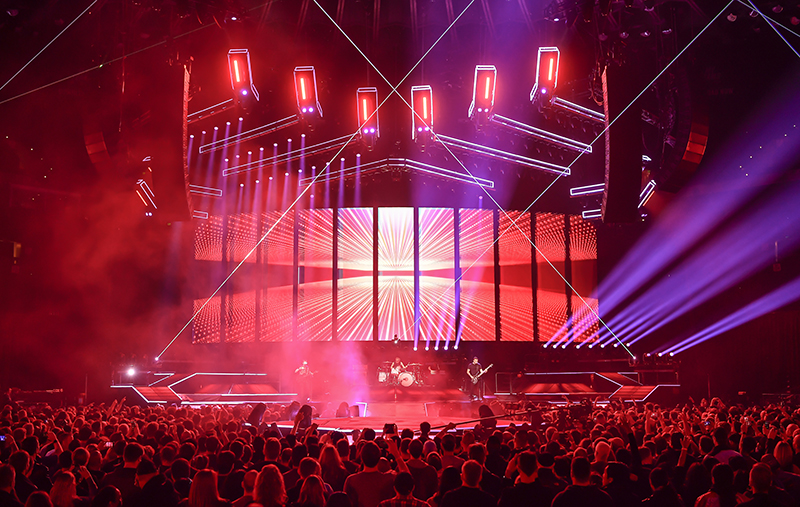
Routhier credits Jesse as a creative director. “We always have a very open dialogue about creative elements. He welcomes any and all ideas to the table — even when they sway outside the lines of a lighting designer’s duty. He originally sent me a SketchUp file with the basic shapes of the stage. I asked if we could add ramps to help push the overall aesthetic of a ‘low poly’ spaceship. I also thought that the ramps would provide an interesting stage canvas for the additional performers to play with. As for the rest of the creative elements, his vision is extraordinary. Anytime he told me about his ‘out of the box’ ideas, I would get super excited about how I could bring them to life or enhance them with light. I like how he created a really unique 80’s Sci-Fi world for Muse.”
The vision is all encompassing, she notes. “It flows through everything, from the album artwork, merch, VIP room, and of course the stage. We wanted to make sure that the lighting for the show added to the Sci-Fi vibe. It was important to play along with all the other elements to make sure that nothing was overpowered or under embellished. It was a pretty delicate balance once we saw all the props and performers together with video and lighting. When I discovered that I was awarded the lighting design for the tour, I was given the official schedule. It included about three months of promo gigs. I really wanted to sink into the Muse world as quickly as I could and decided to program and operate all the shows. For one thing, I’m a massive fan of the music and have been for years. The other reason is that I wanted to make sure that when we started the tour, we would be prepared by understanding the in’s and out’s and what was required to make it successful.”
Because of the promo tour schedule, Routhier ended up with a pretty solid start on the show file. She, Stout and Aaron Luke, the lighting director, did a week in previz leading up to rehearsals. “Upstaging was a dream to work with on this tour,” Routhier adds. “The crew and service is top-notch. They are extremely proactive and attentive. Aaron and I couldn’t be happier to work with them.”
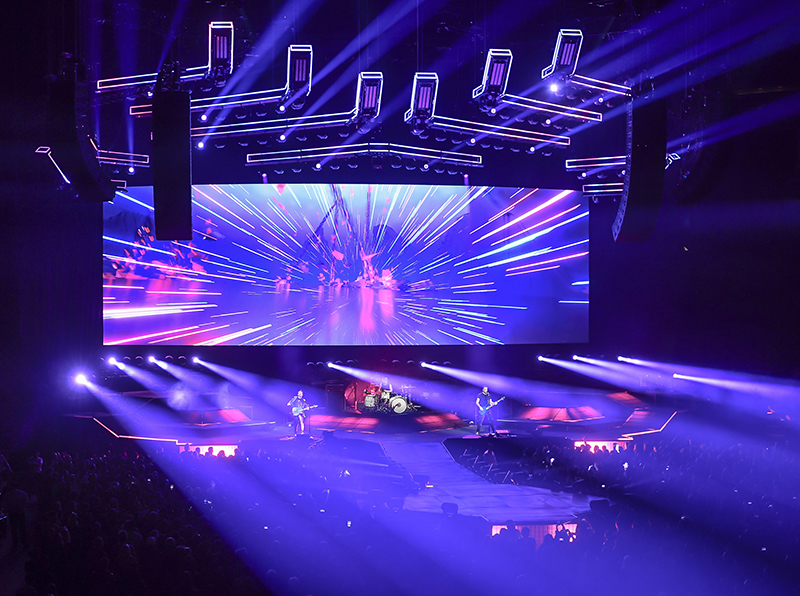
Aaron Luke
Lighting Director
Aaron Luke has worked with Routhier on several different projects dating back to 2012. In the past couple of years, he’s started doing a bit more programming work in between touring. “Sooner mentioned to me in the fall that they were going to be looking for someone to go out with a good size tour. I wasn’t really hands-on until the design was finalized, and the Sooner/SRae team were beginning to get the ball rolling on show file organization. From that point, I was there to support them during previz, production rehearsals and band rehearsals.”
Luke says it’s a very structured show — the band and production design tells a story throughout the two hours. “However, I believe there are about six different songs that have completely alternate song options to go in that place in the set if the band so desires. The band did play with set list order during rehearsals, but once they found what they liked, they’ve stuck to it thus far. We rely on timecode pretty heavily, not only for lighting and video, but also lasers and even audio at times. There are lots of intricacies to the show that are just better served on timecode. With that being said, there are still a handful of moments throughout the show that are totally manual. The band will play the core of a song the exact same every night, but then improvise the endings. Some nights, it’s similar to what they’ve done previously; other nights they’ll go into a totally new, different song just to play around and have fun. Those are not only manual moments, but completely punt situations. And, to be honest, it’s a lot of fun to improvise along with them.”
Luke mentions that, since they have a good-size video wall behind the stage, it’s really important to have fixtures that have the horsepower to keep up, and that’s something all of the fixtures do really well. “The bulk of the rig is comprised of the Claypaky Scenius Unico, Robe MegaPointe and Solaris Flare LR fixtures. All three are just stinkin’ bright. While the LR’s are used a lot for pixels and eye candy, they also serve as our primary crowd blinder. Both the Unicos and MegaPointes do a fantastic job of being workhorses, and their features allow them to also serve a few different purposes throughout the show, from the shapers of the Unicos to the prisms and frost of the MegaPointes. There was a small group of MegaPointes that ended up being used as side wash during various moments of the show.
“As with any production, it takes a team, and I cannot say enough about the support we receive from Upstaging,” Luke says, echoing Routhier’s plaudits. “From the top down, everyone has been extremely helpful and accommodating. Seth Conlin, our lighting crew chief, and the crew he put together are top-notch — they make my days the easiest they can possibly be.”

Tom Kirk
Video Director
Tom Kirk says he’s had the pleasure of working with Muse for over 20 years now, where each tour seems to visually and technically grow from the last. “It’s been an absolute blast to get to this point together.” Working alongside Silent Partners Studio and his company Hidden Road Studios, they created every live camera scene/visual in the show using Notch. “It’s an incredible and very exciting new tech which allows real time rendered live effects resulting in hopefully very filmic, technically dynamic and visually impressive results.”
Kirk is using a Grass Valley Karrera desk at FOH with a bank of two large monitors for all 14 cameras and his 2 x cut featuring program and preview for both outputs. “Another feature we’ve done for the first time is bringing AR to the screen. Using BlackTrax on props and with wireless cameras equipped with BlackTrax sensors, on screen you see a skull on fire in Matt’s hand, when on stage it’s still just a skull. Those type of gags have been used sparingly, but effectively. Another fun trick we use for one song, ‘Take A Bow,’ has a dedicated camera picking up the lasers flying around talent, but with a special rolling shutter implemented in camera and especially controlled in the racks. On screen, it’s kind of like the lasers are floating in slow motion. Pretty cool stuff.”
Kirk says they’ve upgraded cameras with PRG to be 3G compared to standard HD broadcast cameras, giving a whole new level of crisp camera looks to play with in Notch. “I also brought in for the first time a tracking Furio camera along the main thrust from the main stage to the B stage, which brings incredibly cool shots to the show — and noticeably higher quality than previous tours. I kept the pole cam at B stage just because it’s awesome and able to fly away when not required. I also had some robocams overhead main stage and B stage that added some great new angles.”
A more standard layout meant going back to more familiar band placements for the Simulation Theory tour — unlike the last tour, Drones, which was performed in-the-round, notes Kirk. “Here, with a ginormous screen directly behind the band, meant we had to give a lot of thought to making sure there wasn’t ‘video feedback’ occurring in the show. Basically, a lot of careful framing and more cross-shooting from the pit was necessary. We had a good chunk of time in rehearsals, which helped a lot covering all of the new performers brought into this tour which needed to be featured on screen. We worked closely with Jesse to make sure his narrative was brought to life and the choreography was highlighted for its full effect, to come across to those in the farthest seats.
“It’s been another wonderful tour to be a part of,” Kirk concludes. “Thanks to all of the PRG team who have been super-attentive and helpful with so many new video layers we brought to the fore. I’m literally loving being part of every show and if it continues like this — it’s going to a spectacle hopefully people around the world talk about for years.”
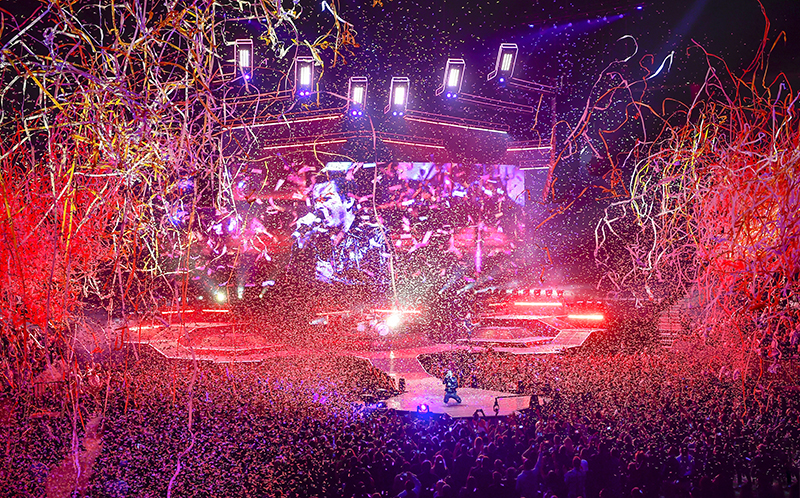
Miles Baldwin
Laser Operator and Special Effects Crew Chief
As crew chief of the three-person special effects team, Miles Baldwin is responsible for all lasers and special effects in the show. With an ER Productions FOH rack running a Beyond Ultimate Universe PC, the system’s capable of running 30 Pangolin FB4 controllers and a MIFF Timecode reader, fed by an audio splitter. That splitter also feeds code into the HES Road Hog 4, which handles all the DMX control that drives 10 Ex25s (ER’s high powered, full color, all OPSL laser system with high speed X/Y scanning and DMX grating effects) on towers placed around the arena and four 30-watt Phaenon lasers on the main stage.
Other highlights in the show are a laser piano and laser pyramid. Baldwin says his duties started back in January in the ER Productions Las Vegas office, organizing and preparing the special effects and laser equipment needed for the tour. Rehearsals were in early February, bringing together all the elements of the show including confetti, streamers, balloons, CO2 guns and low smoke. Programming the show alongside Ross Marshall from ER Productions took the team just over three weeks to complete, ready for the first show in Houston, Texas. “Once the tour was underway, my day-to-day duties involved briefing my team on the layout of the laser tower positions in the arena, loading the show in, focusing all 24 laser zones correctly and safely, and to operate both lasers and low smoke during the show. This left Amy (Stein) to fire confetti and streamers from the Galaxis pyro system and then, finally, loading out.”
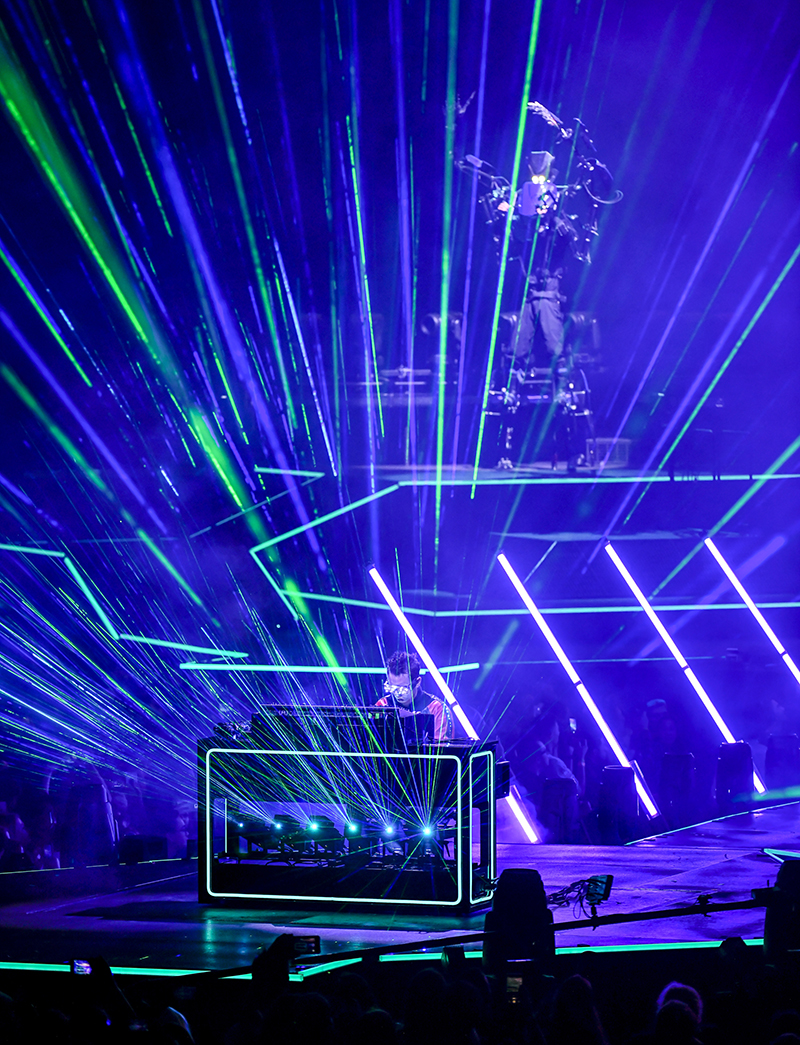
The UPS in the FOH rack means they have powered backup for at least 30 minutes on all FOH systems. They also have feedback coming into BEYOND from the upstage center lifting column. It’s so accurate that if not exactly in the right position, the data will not allow Beyond to trigger that laser, Baldwin notes. “The lifting column allows us to send the laser up above drummer Dominic Howard’s head for specific show sequences.”
On a daily basis, the team rigs 44 lasers, eight confetti blowers, 10 Stadium Shots, eight Cryo-Fog smoke machines, five Cryo-Rifles and 60 black and silver one-meter diameter balloons. The other members of the team are Corey Newton and Amy Stein, and on each show day, they have four local hands to help with the setup. Amy Stein is responsible for shooting the special effects and, with assistance from the hands, sets over 1,000 pounds of CO2, 110 pounds of UV confetti and 2,400 streamers per show.
ER Productions have been working for Muse since their Resistance world tour in 2009, and the shows have always been cutting edge in terms of production. For Simulation Theory, they worked very closely with show designer Jesse Lee Stout to deliver his vision. “This arrangement of lasers is something we have not delivered before, as the focus has generally been towards the opposite end of the stage, but for this show we get to place lasers all the way down the arena on each side,” Baldwin says. “This way the whole audience receives incredible exposure of the laser set up, so it really is an effective and immersive experience for all.”
One of the 30-watt Phaenon units is responsible for creating video content for a specific moment in the show around Matt Bellamy. A rolling shutter camera was used on the down stage edge, to create real timescan-adjusted images on the huge curved LED Wall. The actual laser in real life doesn’t appear to be any different — a cone looks like a cone, but the rolling shutter camera allows the images to be slowed down so it looks like light is actually traveling across the space… “It’s very cool. 30 smaller laser fixtures, ER’s own RGB Beamburst, were used on the B-Stage. As the piano appears from the lift, through Cryo-Fog, and the notes are played, this triggers the beams and grating effects out into the arena.
“Another set of Beamburst are used to create a pyramid of beams collecting at a single point, it’s here that Matt raises the ‘Power Glove’ into this collection of laser beams during the opening sequence. The glove reflects Lumiere type effects and is a great teaser for what’s in store laser-wise throughout the show. From the start we’re using lasers, as lighting effects, as well as projected effects into the audience. It’s not often you produce a show where so many different techniques have utilized all areas of our expertise. Being able to work for Muse has been a great experience as they are a very visual group that like to push technical boundaries when touring. ER Productions’ Ryan Hagan, Ross Marshall, Corey Newton enjoy being part of this creative show where we designed a 360 laser experience for the audience.”
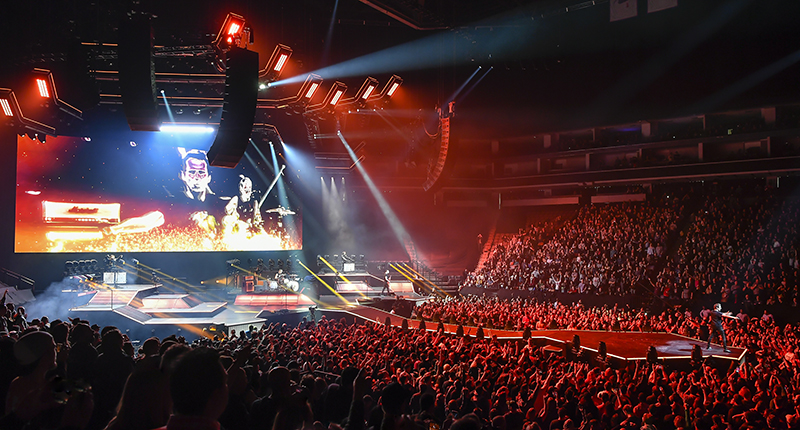
Sidebar
Muse Simulation Theory World Tour
Crew
- Creative Director and Production Designer: Jesse Lee Stout/Metaform.studio
- Lighting Designer and Programmer: Sooner Routhier
- Lighting Director: Aaron Luke
- Tour Manager: Dom Anderson
- Production Manager: George Reeves
- Production Coordinator: Carmen Rodriguez
- Stage Manager: Guy Habosha
- Lighting Co: Upstaging
- Lighting Crew Chief: Seth Conlin
- Lighting Techs: Paul Mundrick, Matt Tucker, Daniel Benavides,
- Benji Meserole, Mike Wright, Gabriel IHM, Kyle Rutkowski,
- Anthony Fiorillo, Amy Kozak
- Upstaging Rep: John Bahnick
- Video Content: Silent Partners, Hidden Road, + Frame48
- Video Content Director: Jesse Lee Stout
- Video Director: Tom Kirk
- Video Programmer: Zach Peletz (Earlybird Visual)
- Video Co: PRG
- Video Crew Chief: Sean “Sharky” Harper
- Video Techs: Alfredo Herz, Dakota Bennett, Steven “Waffles” Lemahieu, Karl Hansen, Grant “Doctor” Draper, Mark Barrow, Jeffrey Apregan, Mark Hughes
- PRG Rep: John Wiseman
- Lasers/Special Effects Co: ER Productions
- Laser Operator and SFX Crew Chief: Miles Baldwin
- Laser Tech: Corey Newton
- Special Effects Tech: Amy Stein
- ER Productions Rep: Ryan Hagan
- Staging/Automation: Tait
- Automation Crew: Robin Henry, Louis: Charles Poudrette, Dwayne Diaz
- Tait Reps: Todd Vernon, Brian Levine
- Props/Inflatables: Airworks/Matthew Whitehead
- Costume Designer: Cristina Acevedo
- BlackTrax Tech: Luke Dobson
- Carpenters: Joe Pollacek (Lead), Chris Ricalis, Sean Jacobs,
- Justin Johnson, Bryan Humphries
- Riggers: Willy Williams, Alberto “Albie” Pozzetti
- Trucking Co: Upstaging
Gear
Lighting:
- 2 grandMA2 Full consoles
- 1 grandMA2 Light console
- 96 Claypaky Scenius Unicos
- 74 Robe MegaPointes
- 24 Robe BMFL Spots
- 6 Chauvet Freedom Par Quad-4
- 1 Color Force II 12
- 354 Saber 1000
- 128 Saber 500
- 129 Saber 250
- 20 Astera AX1 PixelTubes
- 140 Solaris Flare LR’s
- 36 Solaris Flare Q+
- 28 Studio COB UV Pars
- 1 Vari-Lite 6000 Beams
- 4 MGD The One
Video:
- 120 Space Frames
- 240 WinVision 9 Air panels
- 1 Grass Valley Karrera 2 ME production switcher
- 5 Grass Valley LDX 5640/50
- 1 Sony HDC4300 wireless camera
- 6 Panasonic AW-HE130 robocams
- 3 Marshall CV343-CS POV camera
- 1 Aja Rovocam
- 5 disguise GX 2 w/ Notch
- 1 grandMA2 Light console
Lasers/Special FX:
- 1 Pangolin Beyond
- 10 EX 25
- 4 30W Phaenons
- 8 Beam Bursts
- 6 Beam Burst Laser Piano units
- 10 Stadium Shots
- 8 Stadium Blasters
- 4 XL Cryo low smoke
- 1 High End Road Hog 4 console
More Muse Simulation Theory tour photos by Steve Jennings
